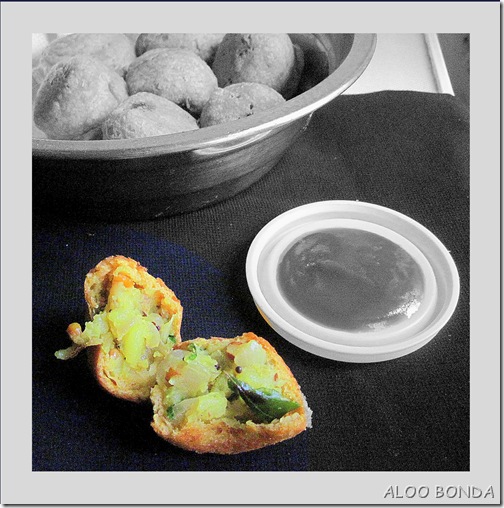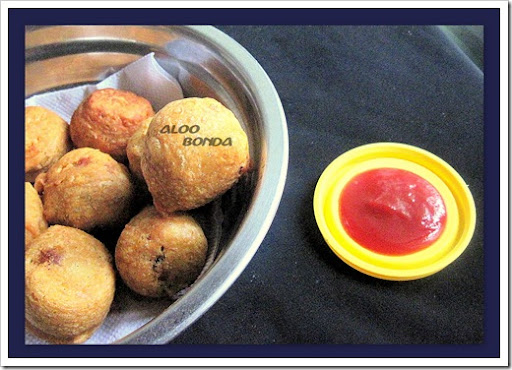Its my long time wish to try this bonda. I very rarely make deep fried snacks especially bhajji & bonda . But my husband is fond of all these fried stuffs.So last weekend i made this bonda for my hubby.He loved it. I was very happy with the result.
INGREDIENTS :
- FOR STUFFING
- Potato - 2 nos (medium sized )
- Green chilly - 1 no (finely chopped )
- Big onions - 1 no (-do-)
- Curry leaves - few
- Ginger - a small piece (Finely chopped)
- Salt & water - as reqd
To temper :
- Mustard seeds - 1/4 tsp
- Urad dal- 1/2 tsp
- Channa dal - 1/2 tsp
- Jeera - 1/4 tsp
To garnish
- Coriander leaves - few
Lime juice - A few drops
- FOR BATTER
- Gram flour - 6 tbsp
- Rice flour - 2 tsbp
- Cooking soda - a pinch (optional)
- Red chilly powder - 1 tsp]
- Hing - 2 generous pinches
- Salt & water - as reqd
METHOD :
- Pressure cook the potatoes ,by adding turmeric powder.Mash it and keep aside.
- In a kadai , temper the ingredients given above. Then add the onions , green chilly pieces & ginger.saute till onion turns transparent.
- Add the curry leaves and the mashed potato.Add little more turmeric powder if needed along with the required salt.
- Saute everything for sometime. It will become a thick mass .Finally mix in the coriander leaves & lime juice.
- Stuffing is ready. Make lemon sized balls out of the stuffing and start to prepare the batter.
- For the batter, take the gram flour , rice flour , red chilly powder , hing and salt in a wide bowl. Mix everything by adding little water and bring it to idly batter consistency.( Take care the batter should not be loose or watery.)
- Heat the oil in a kadai . Dip the lemon sized aloo stuffing in the batter and drop in the hot oil. Cook all the sides and remove. Deep fry all the bondas in batches.
Serve with tomato ketchup or coconut chutney !!
KITCHEN CLINIC :
| POTATO : Potatoes are a very popular food source. Unfortunately, most people eat potatoes in the form of greasy French fries or potato chips, and even baked potatoes are typically loaded down with fats such as butter, sour cream, melted cheese and bacon bits. Such treatment can make even baked potatoes a potential contributor to a heart attack. But take away the extra fat and deep frying, and a baked potato is an exceptionally healthful low calorie, high fiber food that offers significant protection against cardiovascular disease and cancer. Our food ranking system qualified potatoes as a very good source of vitamin C, a good source of vitamin B6, copper, potassium, manganese, and dietary fiber. Potatoes also contain a variety of phytonutrients that have antioxidant activity. Among these important health-promoting compounds are carotenoids, flavonoids, and caffeic acid, as well as unique tuber storage proteins, such as patatin, which exhibit activity against free radicals. Potatoes' Phytochemicals Rival Those in Broccoli Potatoes' reputation as a high-carb, white starch has removed them from the meals of many a weight-conscious eater, but this stereotype is due for a significant overhaul. A new analytical method developed by Agricultural Research Service plant geneticist Roy Navarre has identified 60 different kinds of phytochemicals and vitamins in the skins and flesh of 100 wild and commercially grown potatoes. Analysis of Red and Norkotah potatoes revealed that these spuds' phenolic content rivals that of broccoli, spinach and Brussels sprouts, and includes flavonoids with protective activity against cardiovascular disease, respiratory problems and certain cancers. Navarre's team also identified potatoes with high levels of vitamin C, folic acid, quercetin and kukoamines. These last compounds, which have blood pressure lowering potential, have only been found in one other plant, Lycium chinense (a.k.a., wolfberry/gogi berry). How much kukoamine is needed for a blood pressure lowering effect in humans must be assessed before it can be determined whether an average portion of potatoes delivers enough to impact cardiovascular health. Still, potatoes' phytochemical profiles show it's time to shed their starch-only image; spuds-baked, steamed or healthy sautéed but not fried-deserve a place in your healthy way of eating.'Phytochemical Profilers Investigate Potato Benefits,'Agricultural Research, September 2007 Blood-Pressure Lowering Potential UK scientists at the Institute for Food Research have identified blood pressure-lowering compounds called kukoamines in potatoes. Previously only found in Lycium chinense, an exotic herbal plant whose bark is used to make an infusion in Chinese herbal medicine, kukoamines were found in potatoes using a new type of research called metabolomics. Until now, when analyzing a plant's composition, scientists had to know what they were seeking and could typically look for 30 or so known compounds. Now, metabolomic techniques enable researchers to find the unexpected by analyzing the 100s or even 1000s of small molecules produced by an organism. 'Potatoes have been cultivated for thousands of years, and we thought traditional crops were pretty well understood,' said IFR food scientist Dr Fred Mellon, 'but this surprise finding shows that even the most familiar of foods might conceal a hoard of health-promoting chemicals.' Another good reason to center your diet around the World's Healthiest Foods! In addition to potatoes, researchers looked at tomatoes since they belong to the same plant family-Solanaceae-as Lycium chinense. Metabolomic assays also detected kukoamine compounds in tomatoes. The IFR scientists found higher levels of kukoamines and related compounds than some of the other compounds in potatoes that have a long history of scientific investigation. However, because they were previously only noted in Lycium chinense, kukoamines have been little studied. Researchers are now determining their stability during cooking and dose response (how much of these compounds are needed to impact health). Vitamin B6-Building Your Cells If only for its high concentration of vitamin B6-a cup of baked potato contains 21.0% of the daily value for this important nutrient-the potato earns high marks as a health-promoting food. Vitamin B6 is involved in more than 100 enzymatic reactions. Enzymes are proteins that help chemical reactions take place, so vitamin B6 is active virtually everywhere in the body. Many of the building blocks of protein, amino acids, require B6 for their synthesis, as do the nucleic acids used in the creation of our DNA. Because amino and nucleic acids are such critical parts of new cell formation, vitamin B6 is essential for the formation of virtually all new cells in the body. Heme (the protein center of our red blood cells) and phospholipids (cell membrane components that enable messaging between cells) also depend on vitamin B6 for their creation. Vitamin B6-Brain Cell and Nervous System Activity Vitamin B6 plays numerous roles in our nervous system, many of which involve neurological (brain cell) activity. B6 is necessary for the creation of amines, a type of messaging molecule or neurotransmitter that the nervous system relies on to transmit messages from one nerve to the next. Some of the amine-derived neurotransmitters that require vitamin B6 for their production are serotonin, a lack of which is linked to depression;melatonin, the hormone needed for a good night's sleep;epinephrine and norepinephrine, hormones that help us respond to stress; and GABA, which is needed for normal brain function. Vitamin B6-Cardiovascular Protection Vitamin B6 plays another critically important role in methylation, a chemical process in which methyl groups are transferred from one molecule to another. Many essential chemical events in the body are made possible by methylation, for example, genes can be switched on and turned off in this way. This is particularly important in cancer prevention since one of the genes that can be switched on and off is the tumor suppressor gene, p53. Another way that methylation helps prevent cancer is by attaching methyl groups to toxic substances to make them less toxic and encourage their elimination from the body. Methylation is also important to cardiovascular health. Methylation changes a potentially dangerous molecule called homocysteine into other, benign substances. Since homocysteine can directly damage blood vessel walls greatly increasing the progression of atherosclerosis, high homocysteine levels are associated with a significantly increased risk for heart attack and stroke. Eating foods rich in vitamin B6 can help keep homocysteine levels low. In addition, diets high in vitamin B6-rich foods are associated with overall lower rates of heart disease, even when homocysteine levels are normal, most likely because of all the other beneficial activities of this energetic B vitamin. A single baked potato will also provide you with 11.7% of the daily value for fiber, but remember the fiber in potatoes is mostly in their skin. If you want the cholesterol-lowering, colon cancer preventing, and bowel supportive effects of fiber, be sure to eat the potato's flavorful skin as well as its creamy center. Vitamin B6-Athletic Performance Vitamin B6 is also necessary for the breakdown of glycogen, the form in which sugar is stored in our muscle cells and liver, so this vitamin is a key player in athletic performance and endurance. |


No hay comentarios:
Publicar un comentario